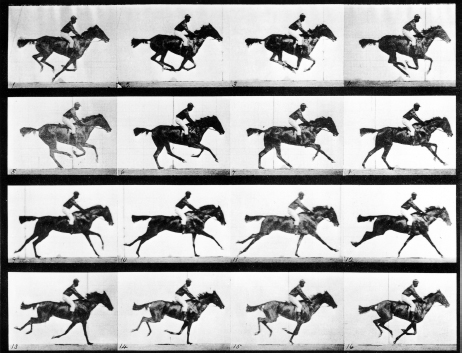Advances in Film Technology
Printed Page 195

The concept of film goes back as early as Leonardo da Vinci, who theorized in the late 1400s that a device could be created to reproduce reality. There were other early precursors to film as well. For example, in the 1600s, the magic lantern projected images painted on glass plates using an oil lamp as a light source. In 1824, the thaumatrope consisted of a two-sided card with different images on each side that appeared to combine the images when twirled. And the zoetrope, created in 1834, was a cylindrical device that rapidly twirled images inside and appeared to make the images move.
But the true development stage of filmmaking began when inventors discovered a process for making a series of photographs appear to move while projected on a screen.
Muybridge and Goodwin Make Pictures Move
Eadweard Muybridge, an English photographer living in America, is credited with being the first person to make images move. He studied motion by using multiple cameras to take successive photographs of humans and animals in motion. By 1880, he had developed a method for projecting the photographic images on a wall for public viewing.
Meanwhile, other inventors were also capturing moving images and projecting them. In 1884, George Eastman (founder of Eastman Kodak) developed the first roll film—a huge improvement over the heavy metal and glass plates previously used to make individual photos. Louis Aimé Augustin Le Prince, a Frenchman living in England, invented the first motion-picture camera using roll film. Le Prince, who disappeared mysteriously on a train ride to Paris in 1890, is credited with filming the first motion picture, Roundhay Garden Scene, in 1888. Recorded at twelve frames per second, the film depicts several people strolling on a lawn and runs for just a few seconds.
In 1889, a New Jersey minister, Hannibal Goodwin, improved Eastman’s roll film by using thin strips of transparent, pliable material called celluloid that could hold a coating of chemicals sensitive to light. Goodwin’s breakthrough enabled a strip of film to move through a camera and be photographed in rapid succession, producing a series of pictures.
Edison and the Brothers Lumière Create Motion Pictures
The early developers of film laid the groundwork for a shift to the entrepreneurial stage. During this stage, inventors came up with new projection and distribution technologies enabling people to come together in a public place to view movies. The action began in the late 1800s, when American inventor and businessman Thomas Edison (with the help of his assistant, William Kennedy Dickson) combined his incandescent light bulb, Goodwin’s celluloid, and Le Prince’s camera to create another early movie camera, the kinetograph, and a single-person viewing system, the kinetoscope. This small projection system required individual viewers to look through a small hole to see images moving on a tiny plate.
Meanwhile in France, brothers Louis and Auguste Lumière developed the cinematograph, a combined camera, film development, and projection system. The projection system was particularly important, as it enabled more than one person at a time to see the moving images on a large screen.

With inventors around the world now dabbling in moving pictures, Edison continued innovating in film. He patented several inventions and manufactured a new large-screen system called the vitascope, through which longer filmstrips could be projected without interruption. This device hinted at the potential of movies as a future mass medium. Staged at a music hall in New York in April 1896, Edison’s first public showing of the vitascope featured shots from a boxing match and waves rolling onto a beach. Some members of the audience were so taken with the realism of the images that they stepped back from the screen’s crashing waves to avoid getting their feet wet.
At this point, movies consisted of movement recorded by a single continuous camera shot. Early filmmakers had not yet figured out how to move the camera itself or how to edit film shots together. Moreover, movies’ content consisted of simply people or objects in motion, without conveying any story. Nonetheless, various innovators had spotted the commercial possibilities of film. By 1900, short movies had become a part of the entertainment industry, used as visual novelties in amusement arcades, traveling carnivals, wax museums, and vaudeville theaters.